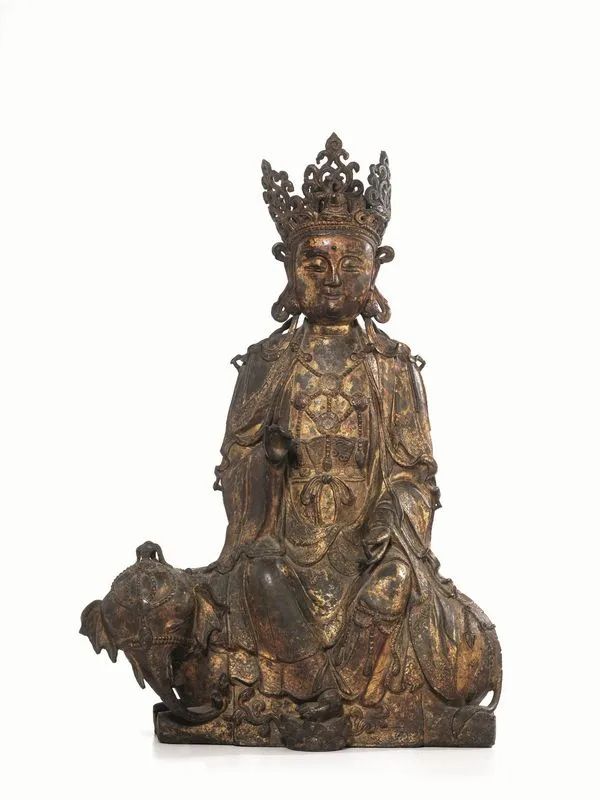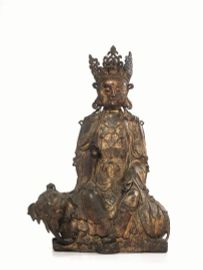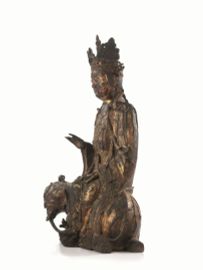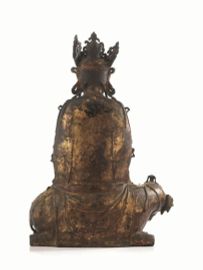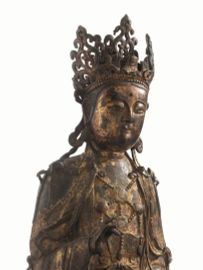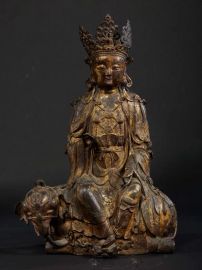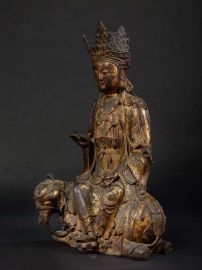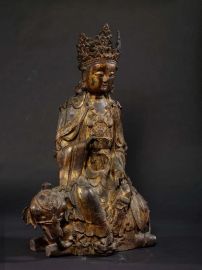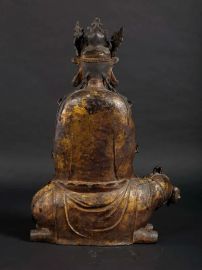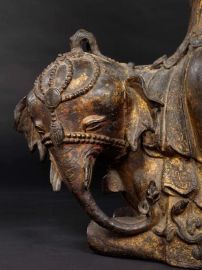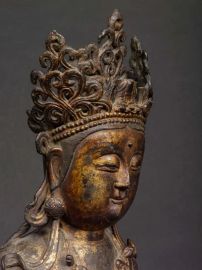A GILT-LACQUERED BRONZE STATUETTE, CHINA, MING DYNASTY, 17TH CENTURY
81,5 cm high
representing Bodhisattva Transforming into Samantabhadra, seated upon an elephant with three pairs of fangs.
The right arm is bent at angle with the index and little fingers in the gesture of karaṇamudrā, while the left arm lies on the leg with the palm turned upward; the crossed feet rest on a lotus flower.
The whole figure is elegantly dressed with a draped robe and adorned with jewels. The head of the divinity is surmounted by a crown, decorated with the image of Buddha Transforming into Amitābha in position of Padmasana.
Samantabhadra, in Chinese 普贤 (Pǔxián), means Universal Worthy and represents Bodhisattva Transforming into Truth, protector in East Asia of those who practise meditation and in Tibet of the active compassion (Kurana).
He is considered protector of the Lotus Sūtra. In the Avatamsaka Sūtra he pronounced the ten great vows in his path to the achievement of Bodhisattva, that is the enlightenment of the being.
In several Buddhist traditions he is referred to as Bodhisattva, while in some others as Primordial Buddha, that means born enlightened.
According to the most popular Buddhist Tang legend, Bodhisattva Samantabhadra reincarnated in an orphan who was later brought to the temple GuoQing (国清寺) by the monk Feng Gan ChanShi (reincarnation of Buddha Transforming into Amitābha) where he grew up under the name of Shide (拾得). He then became one of the most famous Buddhist monks together with Handa Shi (寒大师), reincarnation of Bodhisattva Manjusri. The Buddhist culture would remind the three monks as the "Three Saints of Huayan" (华严三圣, Huayansansheng).
In the traditional iconography Samantabhadra is depicted with clothes and other features common to some representations of Guanyin, like the jewels, the crown and the draped robe.
The figure is also represented seated on a white elephant with six fangs, symbolizing the six ways in which Bodhisattva progresses along the spiritual path to reach the enlightenment and to save the human beings, or the six perfect virtues (Paramita): almsgiving, morality, forbearance, assiduousness, meditation and wisdom.
The earliest records about Bodhisattva Samantabhadra worship go back to China under the Northern and Southern dynasties in the period from 420 to 589 a.C. and then later spread throughout the empire during the peaceful years of the Sui dynasty (581-618) to reach the highest level under the Tang dynasty (618-907).
In order to pay homage to this important divinity of Buddhism, the Mount Emei (峨眉山) was dedicated to Samantabhadra together with the first temple built in 399, and under the Song dynasty a bronze statue was erected in his honour by the second Song emperor.
铜鎏金普贤菩萨坐像, 中国, 明代年间, 十七世纪

